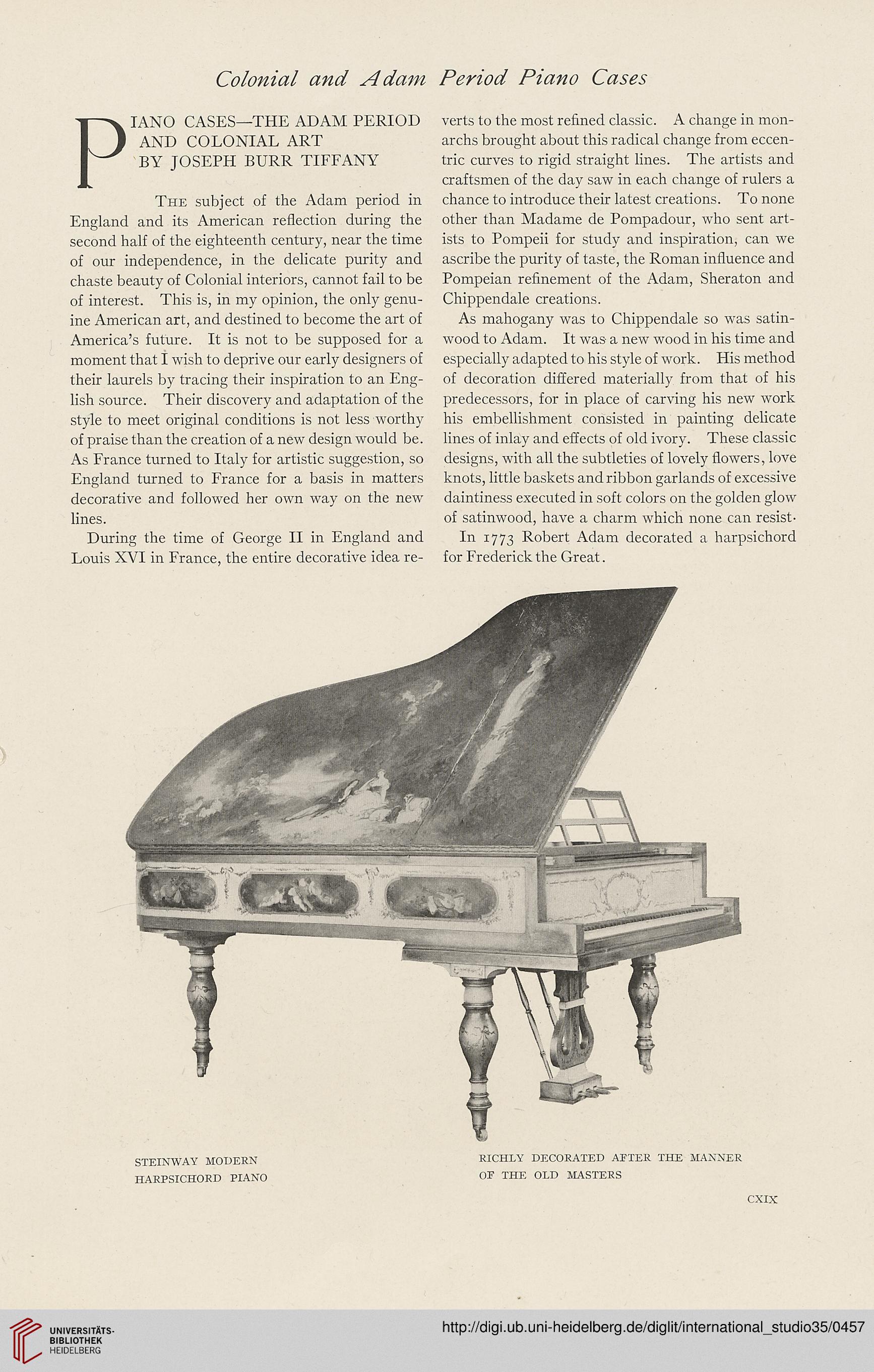Colonial and Adam Period Piano Cases
PIANO CASES—THE ADAM PERIOD
AND COLONIAL ART
BY JOSEPH BURR TIFFANY
The subject of the Adam period in
England and its American reflection during the
second half of the eighteenth century, near the time
of our independence, in the delicate purity and
chaste beauty of Colonial interiors, cannot fail to be
of interest. This is, in my opinion, the only genu-
ine American art, and destined to become the art of
America’s future. It is not to be supposed for a
moment that I wish to deprive our early designers of
their laurels by tracing their inspiration to an Eng-
lish source. Their discovery and adaptation of the
style to meet original conditions is not less worthy
of praise than the creation of a new design would be.
As France turned to Italy for artistic suggestion, so
England turned to France for a basis in matters
decorative and followed her own way on the new
lines.
During the time of George II in England and
Louis XVI in France, the entire decorative idea re-
verts to the most refined classic. A change in mon-
archs brought about this radical change from eccen-
tric curves to rigid straight lines. The artists and
craftsmen of the day saw in each change of rulers a
chance to introduce their latest creations. To none
other than Madame de Pompadour, who sent art-
ists to Pompeii for study and inspiration, can we
ascribe the purity of taste, the Roman influence and
Pompeian refinement of the Adam, Sheraton and
Chippendale creations.
As mahogany was to Chippendale so was satin-
wood to Adam. It was- a new wood in his time and
especially adapted to his style of work. His method
of decoration differed materially from that of his
predecessors, for in place of carving his new work
his embellishment consisted in painting delicate
lines of inlay and effects of old ivory. These classic
designs, with all the subtleties of lovely flowers, love
knots, little baskets and ribbon garlands of excessive
daintiness executed in soft colors on the golden glow
of satinwood, have a charm which none can resist-
In 1773 Robert Adam decorated a harpsichord
for Frederick the Great.
STEINWAY MODERN
HARPSICHORD PIANO
RICHLY DECORATED AFTER THE MANNER
OF THE OLD MASTERS
CXIX
PIANO CASES—THE ADAM PERIOD
AND COLONIAL ART
BY JOSEPH BURR TIFFANY
The subject of the Adam period in
England and its American reflection during the
second half of the eighteenth century, near the time
of our independence, in the delicate purity and
chaste beauty of Colonial interiors, cannot fail to be
of interest. This is, in my opinion, the only genu-
ine American art, and destined to become the art of
America’s future. It is not to be supposed for a
moment that I wish to deprive our early designers of
their laurels by tracing their inspiration to an Eng-
lish source. Their discovery and adaptation of the
style to meet original conditions is not less worthy
of praise than the creation of a new design would be.
As France turned to Italy for artistic suggestion, so
England turned to France for a basis in matters
decorative and followed her own way on the new
lines.
During the time of George II in England and
Louis XVI in France, the entire decorative idea re-
verts to the most refined classic. A change in mon-
archs brought about this radical change from eccen-
tric curves to rigid straight lines. The artists and
craftsmen of the day saw in each change of rulers a
chance to introduce their latest creations. To none
other than Madame de Pompadour, who sent art-
ists to Pompeii for study and inspiration, can we
ascribe the purity of taste, the Roman influence and
Pompeian refinement of the Adam, Sheraton and
Chippendale creations.
As mahogany was to Chippendale so was satin-
wood to Adam. It was- a new wood in his time and
especially adapted to his style of work. His method
of decoration differed materially from that of his
predecessors, for in place of carving his new work
his embellishment consisted in painting delicate
lines of inlay and effects of old ivory. These classic
designs, with all the subtleties of lovely flowers, love
knots, little baskets and ribbon garlands of excessive
daintiness executed in soft colors on the golden glow
of satinwood, have a charm which none can resist-
In 1773 Robert Adam decorated a harpsichord
for Frederick the Great.
STEINWAY MODERN
HARPSICHORD PIANO
RICHLY DECORATED AFTER THE MANNER
OF THE OLD MASTERS
CXIX




